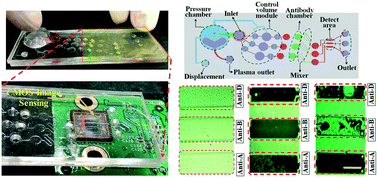Our official English website, www.x-mol.net, welcomes your
feedback! (Note: you will need to create a separate account there.)
Finger-powered agglutination lab chip with CMOS image sensing for rapid point-of-care diagnosis applications.
Lab on a Chip ( IF 6.1 ) Pub Date : 2019-12-24 , DOI: 10.1039/c9lc00961b Chung Hsiang Lu 1, 2, 3, 4 , Ting-Sheng Shih 1, 2, 3, 4 , Po-Chen Shih 1, 2, 3, 4 , Gaurav Prashant Pendharkar 1, 2, 3, 4 , Cheng-En Liu 4, 5, 6, 7 , Chi-Kuan Chen 4, 8, 9 , Long Hsu 4, 5, 6, 7 , Hwan-You Chang 2, 4, 7, 10 , Chia-Ling Yang 1, 2, 3, 4 , Cheng-Hsien Liu 1, 2, 3, 4
Lab on a Chip ( IF 6.1 ) Pub Date : 2019-12-24 , DOI: 10.1039/c9lc00961b Chung Hsiang Lu 1, 2, 3, 4 , Ting-Sheng Shih 1, 2, 3, 4 , Po-Chen Shih 1, 2, 3, 4 , Gaurav Prashant Pendharkar 1, 2, 3, 4 , Cheng-En Liu 4, 5, 6, 7 , Chi-Kuan Chen 4, 8, 9 , Long Hsu 4, 5, 6, 7 , Hwan-You Chang 2, 4, 7, 10 , Chia-Ling Yang 1, 2, 3, 4 , Cheng-Hsien Liu 1, 2, 3, 4
Affiliation

|
Agglutination is an antigen-antibody reaction with visible expression of aggregation of the antigens and their corresponding antibodies. Applications extend to the identification of acute bacterial infection, hemagglutination, such as blood grouping, and diagnostic immunology. Our finger-powered agglutination lab chip with external CMOS image sensing was developed to support a platform for inexpensive, rapid point-of-care (POC) testing applications related to agglutination effects. In this paper, blood grouping (ABO and Rh grouping) was utilized to demonstrate the function of our finger-powered agglutination lab chip with CMOS image sensing. Blood antibodies were preloaded into the antibody reaction chamber in the lab chip. The blood sample was pushed through the antibody reaction chamber using finger-powered pressure actuation to initiate a hemagglutination reaction to identify the blood type at the on-chip detection area using our homemade CMOS image sensing mini-system. Finger-powered actuation without the need for external electrical pumping is excellent for low-cost POC applications, but the pumping liquid volume per finger push is hard to control. In our finger-powered agglutination lab chip with CMOS image sensing, we minimized the effects of different finger push depths and achieved robust performance for the test results with different push depths. The driving sample volume per finger push is about 0.79 mm3. For different chips and different pushes, the driven sample volume per finger push was observed to vary in the range of 0.64 to 1.18 mm3. The red blood cells were separated from the plasma on-chip after the whole blood sample was finger pumped and before the red blood cells reached the antibody chamber via an embedded plasma-separation membrane. Our homemade CMOS image mini-system robustly read and identified the agglutination results on our agglutination lab chip.
中文翻译:

手指供电的凝集实验室芯片,具有CMOS图像感应功能,可用于快速现场诊断应用。
凝集是一种抗原-抗体反应,具有抗原及其相应抗体的聚集的可见表达。应用范围扩展到急性细菌感染,血凝(例如血型)和诊断免疫学的鉴定。我们开发了具有外部CMOS图像感测功能的手指驱动凝集实验室芯片,旨在为与凝集效应相关的廉价,快速即时(POC)测试应用提供支持平台。在本文中,通过血液分组(ABO和Rh分组)来演示具有CMOS图像感应功能的手指驱动凝集实验室芯片的功能。将血液抗体预装到实验室芯片中的抗体反应室中。使用我们的自制CMOS图像传感微型系统,使用手指驱动的压力驱动将血样推过抗体反应室,以启动血凝反应,以识别芯片上检测区域的血型。对于低成本的POC应用而言,无需外部电泵的手指驱动的执行器非常出色,但是每手指推动的泵送液体量很难控制。在我们的具有CMOS图像感应功能的手指驱动凝集实验室芯片中,我们将不同手指按压深度的影响降至最低,并针对不同按压深度的测试结果实现了强大的性能。每次手指推动的驱动样本量约为0.79 mm3。对于不同的切屑和不同的推动,观察到每个手指推动的驱动样本量在0.64至1.18 mm3的范围内变化。在手指抽取全血样本之后,在红血球通过嵌入式血浆分离膜到达抗体室之前,红血球与片上血浆分离。我们的自制CMOS图像微型系统可在凝集实验芯片上可靠地读取并识别凝集结果。
更新日期:2020-02-13
中文翻译:

手指供电的凝集实验室芯片,具有CMOS图像感应功能,可用于快速现场诊断应用。
凝集是一种抗原-抗体反应,具有抗原及其相应抗体的聚集的可见表达。应用范围扩展到急性细菌感染,血凝(例如血型)和诊断免疫学的鉴定。我们开发了具有外部CMOS图像感测功能的手指驱动凝集实验室芯片,旨在为与凝集效应相关的廉价,快速即时(POC)测试应用提供支持平台。在本文中,通过血液分组(ABO和Rh分组)来演示具有CMOS图像感应功能的手指驱动凝集实验室芯片的功能。将血液抗体预装到实验室芯片中的抗体反应室中。使用我们的自制CMOS图像传感微型系统,使用手指驱动的压力驱动将血样推过抗体反应室,以启动血凝反应,以识别芯片上检测区域的血型。对于低成本的POC应用而言,无需外部电泵的手指驱动的执行器非常出色,但是每手指推动的泵送液体量很难控制。在我们的具有CMOS图像感应功能的手指驱动凝集实验室芯片中,我们将不同手指按压深度的影响降至最低,并针对不同按压深度的测试结果实现了强大的性能。每次手指推动的驱动样本量约为0.79 mm3。对于不同的切屑和不同的推动,观察到每个手指推动的驱动样本量在0.64至1.18 mm3的范围内变化。在手指抽取全血样本之后,在红血球通过嵌入式血浆分离膜到达抗体室之前,红血球与片上血浆分离。我们的自制CMOS图像微型系统可在凝集实验芯片上可靠地读取并识别凝集结果。











































 京公网安备 11010802027423号
京公网安备 11010802027423号